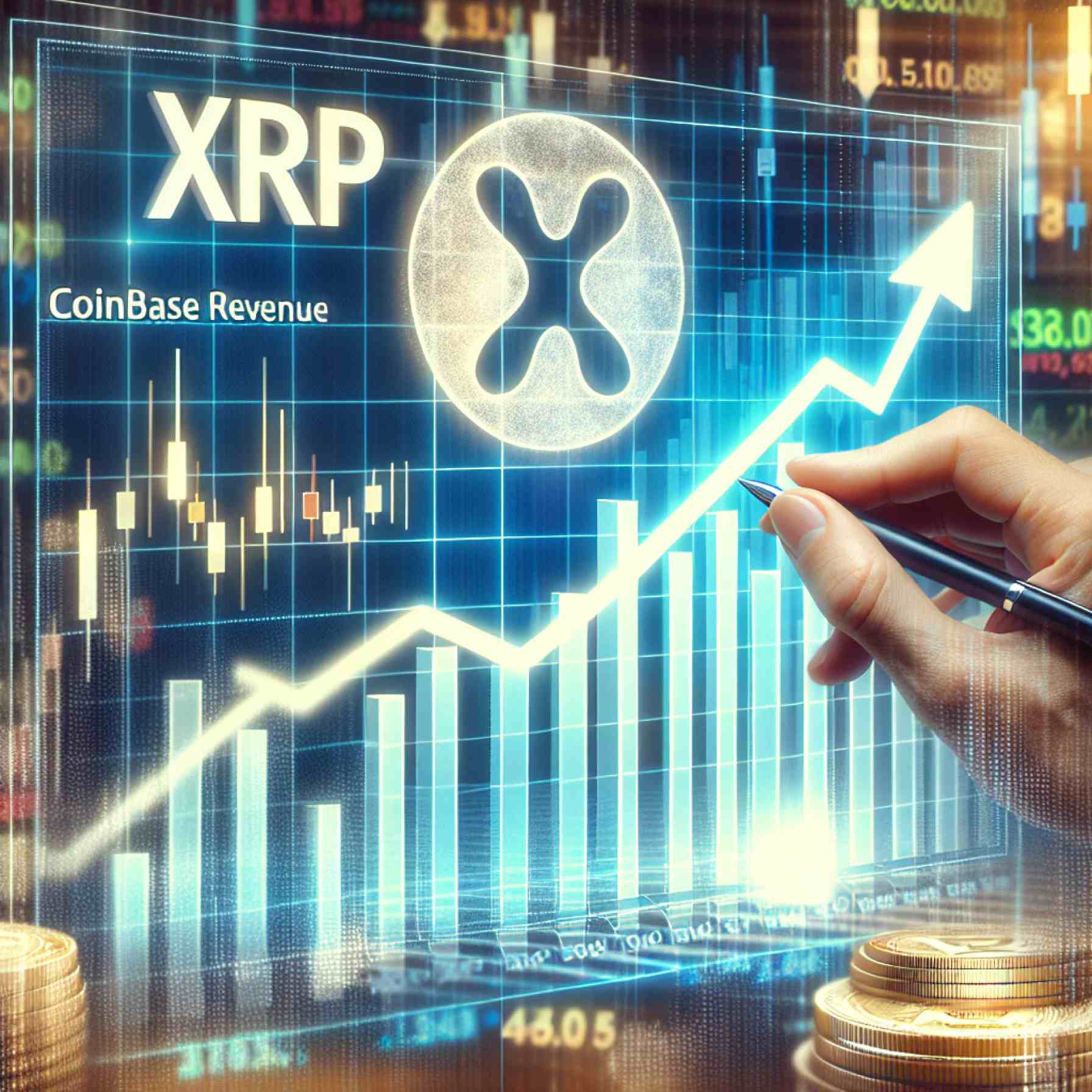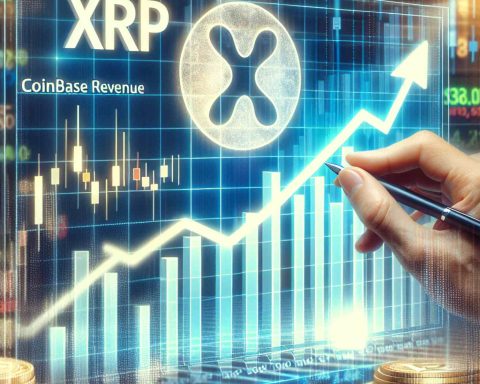- Coinbase, a leading U.S. cryptocurrency exchange, experienced a significant downturn with a 17% drop in retail crypto trading and a 10% decline in revenue.
- Despite the overall market slump, XRP’s performance defied expectations, with transactions on Coinbase surging by 458% in value over a year.
- Ripple’s legal victories, particularly a court ruling affirming XRP sales on exchanges, enabled Coinbase to resume XRP trading after two years.
- XRP became a major contributor to Coinbase’s transaction revenue, second only to Bitcoin, and outperformed Ethereum and Solana.
- The crypto sector faced broader challenges, with Robinhood also reporting revenue declines, reflecting the global economic downturn.
- XRP’s rise highlights the importance of regulatory clarity and adaptability in the cryptocurrency market amid widespread volatility.
The cryptocurrency tides have shifted dramatically, sending Coinbase along a turbulent path marked by sharp declines and surprising surges. While much of the crypto market mirrored the faltering global economy, a beacon of unexpected success emerged: XRP’s robust performance on the Coinbase platform.
Coinbase, the preeminent cryptocurrency exchange in the United States, reported its first quarter earnings with a clear slump—a 17% plummet in retail crypto trading, a stark 10% drop in revenue, and a staggering 94% decrease in net income. These figures starkly contrast with previous growth streaks, as the nosedive mirrored Bitcoin’s 11% decrease over the same period.
Yet, amidst this bleak backdrop, XRP defied expectations. This cryptocurrency outperformed major players like Ethereum and Solana on the Coinbase exchange. XRP transactions surged dramatically, swelling the value held on the platform by an astonishing 458% in a year. Ripple’s legal strides, including a pivotal court ruling affirming that XRP sales through exchanges did not breach securities laws, opened the gates for Coinbase to resume XRP trading after a two-year hiatus.
During the first quarter, XRP commanded a significant portion of Coinbase’s transaction revenue, trailing only behind Bitcoin. The figures for XRP transactions nearly equaled the combined earnings from Ethereum and Solana, a testament to its newfound dominance. This performance is even more impressive considering XRP had been off Coinbase’s trading roster until July 2023.
While overall crypto deposits at Coinbase rose, driven by leaders like Bitcoin and Ethereum, the exchange’s net income remained shackled by the shadow of $600 million in unrealized losses on crypto holdings. This scenario isn’t unique to Coinbase; it reflects a broader retreat in the crypto market coinciding with a global financial downturn that followed a controversial tariff policy.
In this fluctuating environment, Robinhood, a key competitor, also experienced a revenue drop, reinforcing the sector-wide trend. As crypto’s narrative continues to be one of volatility and intrigue, the remarkable rise of XRP amid industry headwinds underscores a critical takeaway: resilience and adaptability are essential for navigating the unpredictable waters of the crypto world.
XRP’s surprising ascent offers a beacon of hope and innovation, illustrating how regulatory clarity can catalyze growth even in turbulent times. As market participants adjust their sails to these new winds, the ripple effect of XRP’s return may herald broader shifts within the crypto economy.
XRP’s Unstoppable Surge: Is This the Dawn of a New Crypto Era?
Understanding XRP’s Meteoric Rise on Coinbase
In the rapidly shifting landscape of cryptocurrency, XRP has emerged as a standout performer on Coinbase, America’s leading crypto exchange. This development intrigues investors and crypto enthusiasts, especially in light of the broader market’s challenges. Here’s a closer look at the dynamics at play.
Ripple’s Legal Victory: A Game Changer
XRP’s recent success ties back to Ripple’s significant legal win, where a court ruling affirmed that XRP sales through exchanges like Coinbase do not constitute securities violations. This verdict marked a watershed moment, allowing Coinbase to relist XRP after a two-year absence.
Key Insight:
– The legal clarity provided by the court ruling was pivotal in bolstering market confidence in XRP, catalyzing its usage and value on Coinbase.
Real-World Use Cases of XRP
XRP isn’t just riding a wave of legal luck; it’s instrumental in real-world financial solutions. Ripple aims to facilitate seamless global payments, which traditional banking channels often struggle to manage efficiently due to high fees and slow processing times.
Use Cases Include:
– Cross-Border Payments: XRP’s technology reduces transaction times from days to seconds, making it ideal for international money transfers.
– Liquidity Solutions for Financial Institutions: XRP serves as a bridge currency in cross-border transactions, helping banks manage liquidity more effectively.
Market Trends: The Rise of Institutional Interest
Over the past few months, institutional interest in cryptocurrencies, including XRP, has increased. As regulatory frameworks evolve and as digital assets gain legitimacy, more traditional finance players are entering the crypto space.
Insights:
– Institutional Influx: The return of XRP to Coinbase reflects changing attitudes among institutional investors seeking diversified crypto portfolios.
– Technological Advancements: Ripple’s ongoing technological advancements make XRP a favorable option for institutions looking for scalable blockchain solutions.
How to Navigate and Invest in XRP
If you’re considering investing in XRP, here’s how you can approach it:
Steps:
1. Research Intensively: Understand XRP’s unique value proposition compared to other cryptocurrencies.
2. Monitor Exchange Listings: Keep an eye on platforms offering XRP trades, including recent re-listings like Coinbase.
3. Stay Informed About Regulations: Regulatory changes can impact cryptocurrency valuations significantly.
4. Diversify Your Portfolio: While XRP shows promise, mitigate risks by diversifying across other crypto assets.
Pros and Cons of Trading XRP
Pros:
– Speed and Efficiency: Fast transaction times and low fees make XRP appealing for transactions.
– Legal Clarity: Recent rulings have reduced regulatory uncertainty, providing a more stable investment environment.
Cons:
– Volatility: Like all cryptocurrencies, XRP is subject to market volatility.
– Centralization Concerns: Some critics argue that Ripple’s control over XRP undermines decentralization principles.
Recommendations and Final Thoughts
Actionable Tips:
– Keep updated on Ripple’s court rulings and their implications for XRP.
– Consider the trend of increasing crypto adoption among institutional investors to gauge market movements.
– Educate yourself on blockchain technology and how it underpins XRP’s value proposition.
In conclusion, XRP’s ascent in the crypto sphere, underscored by Coinbase’s trading figures, highlights the currency’s potential amid broader market challenges. Understanding the intersection of regulation, technology, and market dynamics is crucial for capitalizing on XRP’s future opportunities.
For more insights into the world of cryptocurrency and blockchain technology, explore Coinbase and Robinhood.











